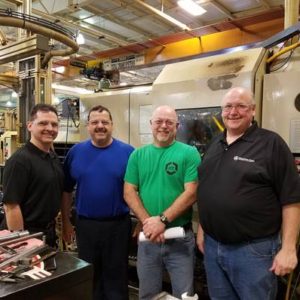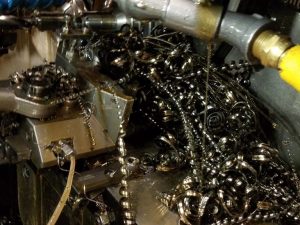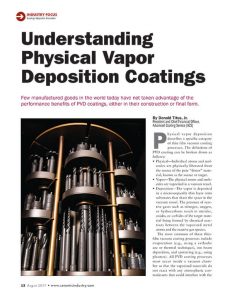
As a design engineer in the machining industry, you have the important responsibility to establish efficiencies that ensure the survival of your company and welfare of your team. In order to stay competitive, you must find ways to reduce material cost and machine downtime.
This was certainly the case for our friends at MacLean-Curtis, LLC – a leading supplier of precision CNC and screw-machined components (a division of MacLean-Fogg Component Solutions [MFCS]).
PROBLEM: 22% DOWNTIME CAUSED BY CLEARING CHIPS
A MacLean-Curtis Lean Basic PDCA team sought to reduce machine downtime caused by clearing chips. A multi-spindle machine had to be stopped at least 50x per shift every 10 min for a 2-min micro-break to clear chips away from the tooling area. Addressing chip buildup was a must due to how excess chips cause tool damage or tool holder blowout.
SOLUTION: CHIP-BREAKER DESIGN WITH NANOCOMPOSITE COATING
 The team worked with a design engineer who previously converted tooling to chip-breaker designs. They made a plan to reduce chip formation at the tool edge. This formation was caused by red-hot steel being removed in fine strips.
The team worked with a design engineer who previously converted tooling to chip-breaker designs. They made a plan to reduce chip formation at the tool edge. This formation was caused by red-hot steel being removed in fine strips.
After adding a chip-breaker design to the forming tool, the engineer consulted our technicians at Advanced Coating Service (ACS). They sought suggestions on the latest hard coating technology to provide superior performance for this specific application. ACS recommended the newer TiAlN/Si3N4 nanocomposite coating (nACo) – due to its durability in high-heat and high-friction cutting applications.
While machining, the newly coated chip-breaker creates a ramped feature on the top edge of the tool 0.020-030” back from the cutting edge. The chip forms at the cutting edge, travels this short distance, and then breaks off when changing direction up the ramp. The nanocomposite coating is able to reduce friction at the cutting edge and along the chip formation path. This assists in rapid chip removal with reduced chance of chip buildup that could lead to a blowout.
REDUCED ANNUAL TOOL COST BY $7,800 & DOWNTIME BY 30 MIN
Reengineering the tool with the chip-breaker design and nanocomposite coating allowed for these advantages:
- • 47% increase in tool life (going from 1,700 to 2,500 cycles per tool change)
- • Reduced tool change frequency
- • $7,800 annual tool cost reduction
- • 200-piece increase in production per shift
Due to these impressive results, another tool has been redesigned and is in testing. With both tools in place, the necessary micro-break downtime is expected to be reduced by more than 30 min per shift, which will also impact tool life and tool changeover.
CAN PVD COATING TECHNOLOGY OPTIMIZE YOUR APPLICATION?
We believe engineers like you can reduce cost and downtime, as did the MacLean-Curtis team, by applying PVD coating technology to your tooling designs. If this is important or interesting to you, read more about PVD coatings in our recent article published by Ceramic Industry Magazine.
READ THE ARTICLE FROM CERAMIC INDUSTRY
